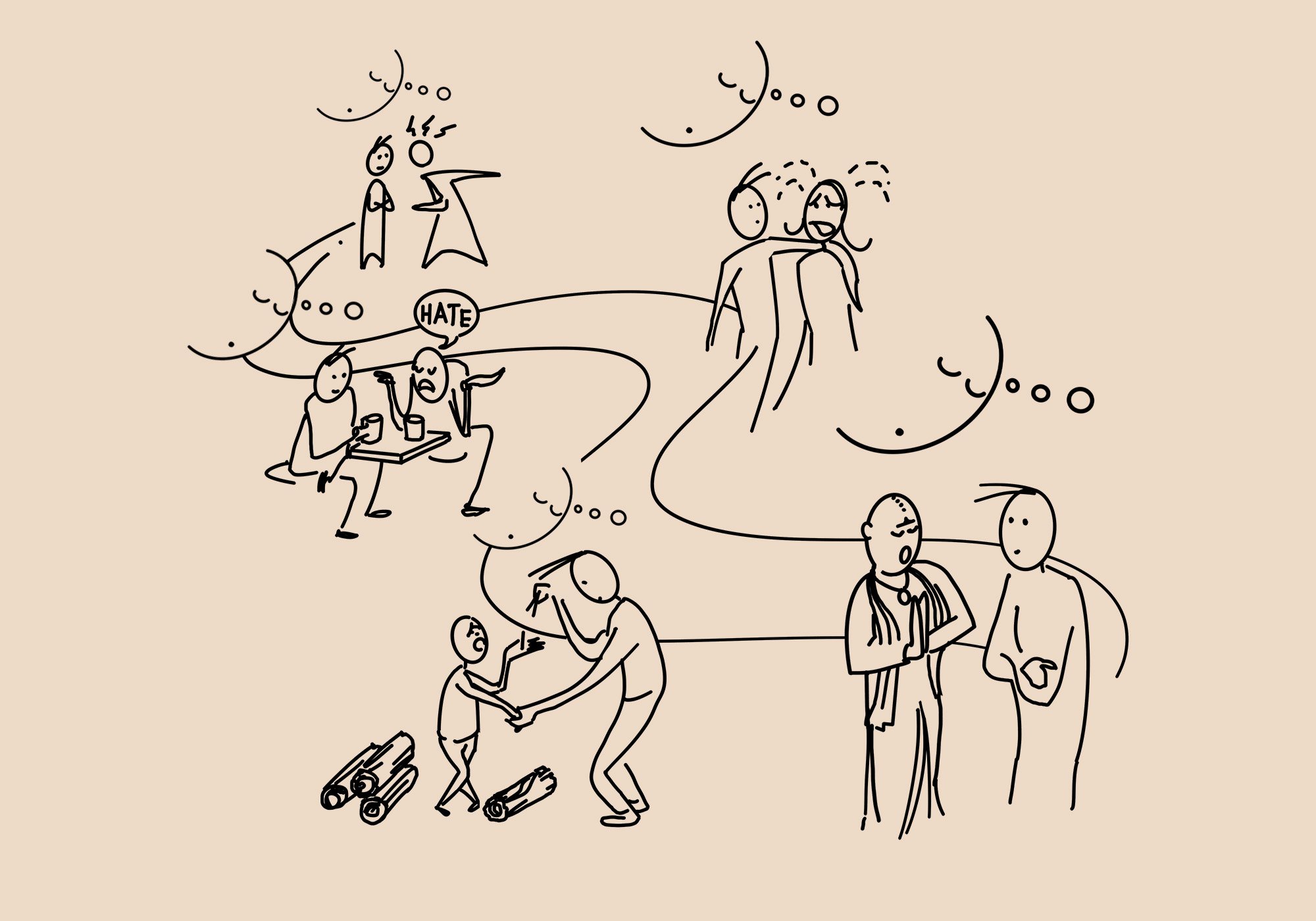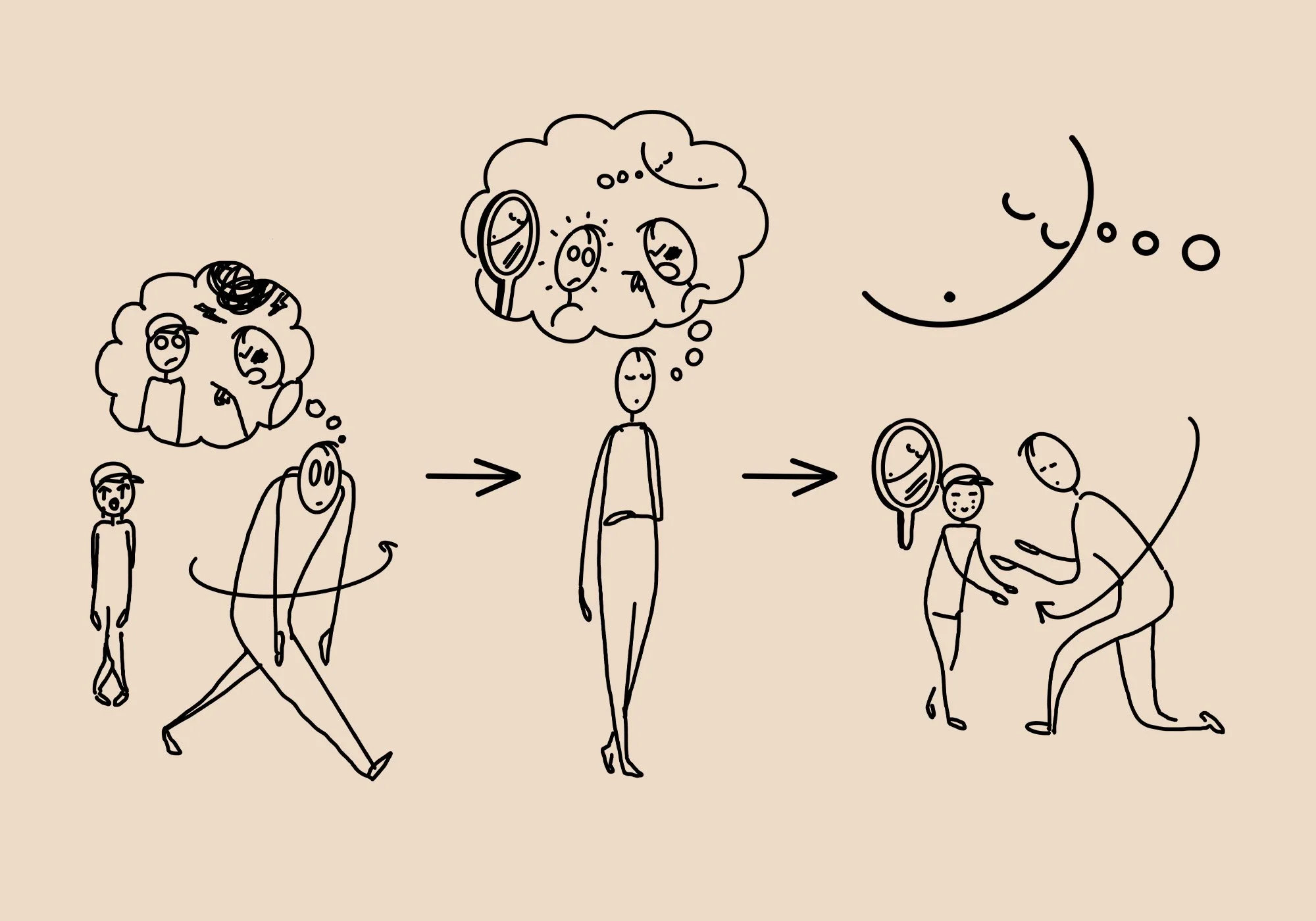MIND-FIRST PRACTICES
Field Tests in Relationship
Collective perception experiments for testing one shared mind through the friction of relationship.
Last updated: October 9, 2025Practice Finder
Find the field test that fits your moment.
shared silence · group meditation · first eye contact · family gathering · creative collaboration · feeling distant from others · helping a friend · giving advice · mentoring · co-creating · caregiving · emotional support · teaching moment · argument at home · blame exchange · tense conversation · apology in progress · miscommunication · receiving criticism · witnessing anger · debate at work · political disagreement · creative difference · moral dilemma · competing views online · performance comparison · workplace pressure · boundary test · social expectation · difficult request · inner “should” voice · fear of disapproval · after argument · self-critique loop · late-night rumination · habit relapse · missed opportunity · apology reflection · memory replay · attraction moment · porn addiction · sexual tension · comparing appearances · judging looks · self-image doubt · advertisement influence · envy spark
RELATIONAL DESIGN
The mind meets itself through others.
Every exchange
is a mirror — testing whether we see
a world of separation, or
one awareness
playing both sides.
In the consciousness-first experiment, relationship is the most direct lab: a field where identity dissolves, empathy becomes recognition, and perception learns to include. Each interaction — tense, tender, or ordinary — becomes a test site for shared mind.
To practice together is to remember together: awareness joining awareness through the dream.
[VISUALIZATION:]
1. Within Selves Interlinked — Joining the Dreamer Between Us
Collective visualization for dissolving the illusion of separateness.
Field sketch — visual cue, not final symbol — awareness turning outward through the Dreamer’s mind to dream the world together.
If consciousness comes first, then we don’t just look at the world — we look from within the mind that dreams it. Within Selves Interlinked is a visualization for testing that shift: what happens when we imagine all perspectives — yours, mine, everyone’s — not as separate observers, but as faces of one field of perception?
In this exercise, the phrase “Within selves interlinked” becomes a visual key, not a mantra. It reminds the mind to flip orientation — from inside the dream to the source of dreaming.
Tool Usage: Begin inward — close your eyes and imagine the mind as a vast, luminous space — awareness before form. See the heads turn — visualize countless beings, all facing outward from this single mind — not separate bodies, but many lenses through which one awareness perceives. Feel the linkage — sense that every perception, every movement, every breath is connected — threads in the same living fabric of mind. Repeat softly: “Within selves interlinked” — let the phrase dissolve the sense of boundary until what’s left is one dreamer seeing through many eyes.
Rest in the shared field — stay here briefly. The world still runs — the cities, planets, and people all move — but perception now knows: the dream makes itself.
Why It Matters: Because the illusion of separateness fuels every layer of conflict. This visualization tests a radical alternative — that the world, like a night dream, unfolds from one mind imagining itself as many. To remember that link, even momentarily, is to glimpse the Dreamer dreaming the whole.
This practice explores:
Principle 2 — Separation Exists → Only Appearances of Separation
Principle 4 — Identity Is Personal → Identity Is Universal

All drawings by Martin Lenclos. These are field sketches — visual cues for perception shifts. They’re not polished artworks or fixed symbols, but provisional notes from the experiment: playful, imperfect, and open to your own interpretation.
[RELEASE:]
2. Let Oneness Flow with All — Embracing a Relationship with the Dreamer
Letting go of effort and self-authorship in healing or spiritual striving
Field sketch — visual cue, not final symbol — awareness relaxing its grip and letting the same current flow through self and other.
If We The Dreamer proposes that one mind dreams the world, then this practice tests that premise at the level of relationship and authorship.
In the consciousness-first experiment, every interaction is the Dreamer meeting itself through many forms. Yet the mind often tries to manage, guide, or “improve” that meeting — believing it must fix, teach, or heal what already unfolds perfectly within the shared field.
This test asks: what changes when we release that control and let oneness flow between us?
The Practice: Notice — when you feel the need to steer — to fix, convince, comfort, or spiritually “help” another. Test — say softly, “Let oneness flow.” Sense the current that animates both of you — one awareness breathing through two forms. Hold: ~3 seconds. Let the mental effort dissolve; feel attention widen to include both perspectives at once. Act — respond only when moved from that shared stillness. Let words or silence arise naturally, without agenda.
Where to Test It: during heartfelt conversation or conflict resolution, when you sense emotional charge or spiritual performance in helping, in intimate silence with a loved one, in moments of co-creation, teaching, or guidance.
Micro-Cue: “Not mine to steer — let oneness flow.”
Pairs With: Within Selves Interlinked
This practice explores:
Principle 6 — Love Is Between → Love Is Recognition
Principle 9 — Awakening Is an Attainment → Awakening Is a Return
Principle 10 — We Are Lost → We Are Dreaming
[RELEASE:]
3. Not Me vs You, But Us in One — Responding as the Dreamer in Moments of Conflict
A field test for relational undoing and emotional de-polarization.
Field sketch — visual cue, not final symbol — awareness staying lucid while the dream of conflict plays out.
If We The Dreamer proposes that one mind dreams the world, then this practice tests that premise in the heat of human interaction—where separation appears most convincing.
When accusation, misunderstanding, or blame arises, the reflex is to defend, justify, or collapse. Yet every “me vs you” contains the same hidden structure: two frightened selves protecting the same illusion. The consciousness-first experiment reframes such encounters as opportunities to verify whether perception can hold steady even inside the storm of duality.
To practice Us in One is not to passively endure or to spiritually bypass. It is to stay lucid in relationship—testing whether awareness can remain larger than the story, compassionate without surrendering clarity, and steady enough to remember that both roles belong to one field.
The Practice: Notice — when confrontation, criticism, or blame appears—especially when directed at you. Pause — before responding, silently recall: “Not me vs you, but us in one.” Reframe — see both characters as expressions of the same dreaming mind, both seeking safety or recognition in different languages. Respond — gently name the shared difficulty (“This is hard for both of us”), or simply hold silence while keeping your heart open. Observe — how the charge changes—not by control, but by inclusion.
Where to Test It:
in heated dialogue or argument
when someone projects anger or blame
during family or partner tension
while witnessing another’s pain or overreaction
Micro-Cue: “Not two in conflict — one field remembering itself.”
Observable Markers: defensiveness drops; breath steadies; empathy returns without loss of boundaries; guilt or blame dissolve into understanding; situation softens or resolves without verbal victory.
Field Notes — A relational experiment from The Dreamer Project. The practice was inspired by witnessing small real-world collisions—literal and emotional—where defensiveness dissolved into awareness. Each test invites the same hypothesis: can love outlast the reflex to separate?
This practice explores:
Principle 2 — Separation Exists → Only Appearances of Separation
Principle 7 — Conflict Is Real → Peace Is What Is
[THOUGHT:]
4. Two Flip Sides to One Dream of Separation — Recognizing the Dreamer Behind Opposites
A perception experiment for dissolving polarity in relationship and thought.
Field sketch — visual cue, not final symbol — one coin, two dreams, one mind watching.
If We The Dreamer proposes that one mind dreams the world, then this practice tests that premise at the level of separation and polarity. In the consciousness-first experiment, every clash—between people, ideas, or desires—is the same mind arguing with itself. Each side believes it’s right, yet both are dream-characters animated by the same field. This experiment asks: what changes when you stop choosing sides and see both as movements within one dream of separation?
The Practice: Notice — when conflict arises—disagreement, competition, or the urge to win. Test — say quietly, “Two flip sides to one dream of separation.” Picture a coin engraved with both views—you/me, right/wrong, success/failure—flipping in the air, then melting back into the palm of the Dreamer. Hold — for ~3 seconds; let the charge neutralize as awareness widens. Act — from that shared field—listening, speaking, or pausing—not to correct, but to see through.
Where to Test It:
in arguments, debates, or creative disagreements
during political or ideological tension
when reacting to criticism or praise
while judging or defending a point of view
Micro-Cue: “Two sides, one dream.”
Observable Markers: defensiveness fades; humor or curiosity appears, perception softens around right/wrong, compassion for both sides arises naturally, conversation shifts from attack to awareness
Pairs With: We The Dreamer · Let Oneness Flow with All
This practice explores:
Principle 2 — Separation Exists → Only Appearances of Separation
Principle 7 — Conflict Is Real → Peace Is What Is
[MANTRA:]
5. Only Love Commands — Returning Authority to The Dreamer
A field test for interrupting unconscious obedience when fear masquerades as authority.
Field sketch — visual cue, not final symbol — awareness standing firm within the dream, untouched by division.
If We The Dreamer proposes that one mind dreams the world, then Only Love Commands tests that premise in moments of pressure—when outer authority or inner guilt demands obedience against peace. In the consciousness-first experiment, love is not emotion exchanged between selves but the recognition of unity itself. If consciousness is one, love is its nature—and nothing divided can truly command it.
This mantra filters all direction through that truth. When a role, voice, or demand asks you to harm, shame, divide, or perform against essence, silently repeat: Only love commands. It refuses what is unloving not by rebellion, but by lucid non-compliance. And sometimes, when no peaceful exit seems available, the Dreamer may still choose to comply outwardly—without defense, without inner surrender—waiting for the moment clarity allows a quiet opt-out. Even that, done lucidly, is part of the experiment.
The Practice: When someone—or some internalized “should”—pressures you to act against peace.
Test — pause and say inwardly, “Only love commands.”
Hold — for ~3 seconds; sense whether the impulse before you is rooted in love or fear.
Act — respond only from what feels undivided, even if that means silence or delay.
Where to test it:
In conversations charged with guilt or moral pressure.
When a boss, partner, or social script asks for compliance that feels off.
When your own “good person” reflex overrides inner peace.
Micro-cue: “If it’s not love, it has no authority.”
Observable markers: Guilt softens; calm clarity emerges; Body tension drops around chest and throat; Speech slows or becomes gentler; A subtle relief in refusing without resistance; Applying the order without defense; inwardly unbound.
This practice explores:
Principle 6 — Love Is Between → Love Is Recognition
Principle 7 — Conflict Is Real → Peace Is What Is
[RELEASE:]
6. Once Recalled, Oneness Restored — Dreaming Guilt, Regret, Shame
A perception experiment for returning reactive moments to awareness.
Field sketch — visual cue, not final symbol — awareness remembering one mind behind guilt, releasing the cycle of self-blame into the Dreamer’s field.
If We The Dreamer proposes that one mind dreams the world, then this practice tests that premise at the level of personal remorse. In the consciousness-first experiment, guilt and shame are not moral weights but after-images of identification with the doer. The question is simple: what happens when even regret is seen as part of the dream—released, not repaired?
The Practice: Notice — the moment after reaction—when guilt, regret, or shame arises. Test — say softly, “Once recalled, oneness restored.” Visualize handing the scene back to the Dreamer: the act, the feeling, and the judgment, all returned to the field that dreamed them. Hold — ~3 seconds; sense the contraction easing, the story thinning. Act — continue from awareness, not defense—if apology or repair is needed, let it come from clarity, not guilt.
Where to Test It:
after saying or doing something you regret
during self-critique or rumination
when old habits resurface
before sleep reflection on the day
Micro-Cue: “Return it to the Dreamer.”
Observable Markers: guilt loses density, self-image loosens, warmth or neutrality replaces self-attack, memory remains, but sting fades
Pairs With: Choose Again
This practice explores:
Principle 4 — Identity Is Personal → Identity Is Universal
Principle 10 — We Are Lost → We Are Dreaming
[REMINDER:]
7. Just Drawn That Way — Seeing Through the Dream of Form
A field test for interrupting projection, lust, or judgment when form feels personal or powerful.
Field sketch — visual cue, not final symbol — The Dreamer seeing form as sketch, not essence.
If We The Dreamer proposes that one mind dreams the world, then Just Drawn That Way tests that premise at the level of form, taste, and desire. When attraction or repulsion grips you—a face, a curve, a gesture—it feels charged, as if the form itself holds power. This reminder cuts through the spell: “Just drawn that way.”
Not to shame or suppress, but to see clearly: bodies are projections within the dream, animated by memory, culture, and conditioning. The meaning you assign isn’t in the form—it’s in mind. The phrase breaks the trance without judgment, returning perception to the shared conscious essence of oneness.
The Practice: Notice — when attraction, envy, or judgment fixes on a body or image. Test — pause and whisper inwardly, “Just drawn that way.” Hold — for ~3 seconds; feel curiosity replace charge as the image softens. Act — stay with the seeing, not the story; let form be appearance without ownership.
Where to test it:
When sexual or aesthetic projection arises (ads, strangers, screens)
When judging a body—yours or another’s
During comparison, shame, or idealization loops
When physical attraction feels fused with identity or value
Micro-cue: “Perception draws; the Dreamer sees.”
Observable markers: Bodily tension or craving eases; The other person feels less object-like, more luminous; Humor or tenderness replaces shame or desire; Momentary sense of shared field beyond form; Awareness returns to neutrality without suppression.
This practice explores:
Principle 2 — Separation Exists → Only Appearances of Separation
Principle 4 — Identity Is Personal → Identity Is Universal
*ABOUT THIS EXPERIMENT
The Dreamer Project and its affiliated materials (including “We The Dreamer” and the Practice Library) explore a consciousness-first worldview through creative and phenomenological means. These materials are experimental in nature. They make no claims of scientific proof or therapeutic efficacy. No empirical evidence currently confirms or denies the hypothesis that consciousness is fundamental to reality, nor that these practices produce measurable benefits. Participation in this project is voluntary and self-directed. It may surface challenging reflections or unsatisfying results; that possibility is part of the inquiry. If you are navigating mental-health concerns or emotional distress, please seek guidance from a qualified professional. This work is offered freely for educational and philosophical exploration only — a field test in perception, not a path of belief.
Have you tried the project’s core creative experiment, where the premise first becomes lived—We The Dreamer?
META NOTES
This page is a living document. Last updated: Newly created on October 9, 2025







